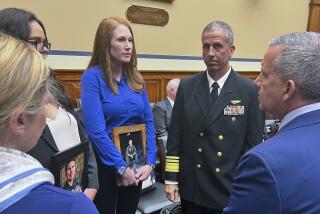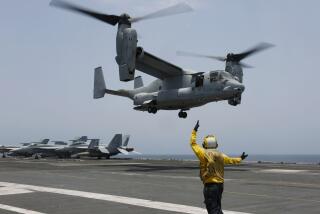Osprey Flight Tests Will Resume After Fleet Was Grounded
- Share via
LEXINGTON PARK, Md. — Flight tests on the V-22 Osprey will resume today for the first time since the helicopter-airplane hybrid was grounded in 2000 after two fatal crashes, the Marines said Tuesday.
Marine officials said that steps have been taken to correct problems that led to the crashes.
“We are returning a safe and operational aircraft to the fleet,” said Col. Dan Schultz, the Marine Corps’ V-22 program manager.
Over the next year, the military will test seven modified V-22s at the Naval Air Station at Patuxent River and four at Edwards Air Force Base in the California desert.
Pilots will take the planes through a series of maneuvers, including fast descents, to determine whether changes in hydraulic systems and other modifications have corrected problems that led to the crashes.
The Marines hope to have the V-22 in service by December 2003, Schultz said.
The Osprey is designed to lift off and land vertically like a helicopter and cruise like an airplane. It uses two propellers that can tilt 90 degrees. The Marine Corps hopes to replace its aging fleet of assault helicopters with the Osprey.
Built by Boeing Co. and Bell Helicopters Textron, the V-22s cost $89.7 million each. Only 20 have been built so far.
The entire fleet was grounded in 2000 after two crashes that year during training flights. A crash in December 2000 killed four Marines in Jacksonville, N.C., and 19 Marines died when a V-22 crashed in Arizona in April 2000.
An investigation found several Marine officers took part in a plan to exaggerate the readiness of the aircraft by doctoring maintenance records. Two officers received letters of reprimand in September.
One of the crashes was attributed to vortex ring state, a phenomenon that can cause an aircraft to lose altitude quickly. Schultz said changes had been made to alert pilots to conditions that could lead to VRS.
V-22 pilots will be trained to maneuver out of VRS situations, and technicians have also changed the V-22’s hydraulic system to prevent failures caused by chafed hydraulic lines, he said.
“The indications are that this aircraft can handle VRS better than any airplane and any helicopter out there,” Schultz said.
Flight tests will be conducted by pilots from Boeing and Bell Helicopter at Patuxent River.
“We’ll know the first day of flying if this airplane is put together right,” said Tom McDonald, a Boeing test pilot, who will fly the aircraft.
More to Read
Sign up for Essential California
The most important California stories and recommendations in your inbox every morning.
You may occasionally receive promotional content from the Los Angeles Times.










